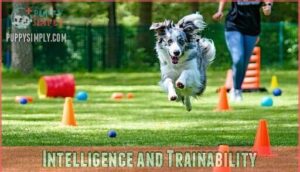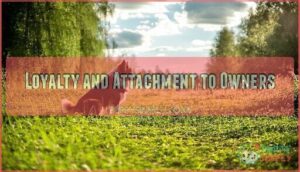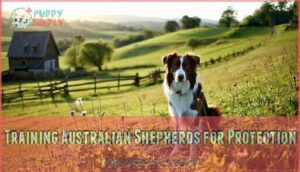This site is supported by our readers. We may earn a commission, at no cost to you, if you purchase through links.

Here’s the reality: Australian Shepherds account for just 1.1% of dog-human aggression cases, and there’s a vital distinction between their natural watchdog instincts and the trained aggression of breeds specifically developed for protection work. While 89% of Aussies display protective barking, their herding heritage programmed them to alert and monitor rather than attack and defend.
Understanding whether this intelligent, energetic breed matches your security needs requires looking past the impressive bark to examine what protection really means—and whether their guardian traits align with what you’re actually looking for in a family companion.
Table Of Contents
Key Takeaways
- Australian Shepherds excel as watchdogs through alertness and protective barking (89% display this trait), but they’re not true guard dogs since they’re bred to alert and monitor threats rather than physically confront them.
- With just 1.1% involvement in dog-human aggression cases and 93% of owners reporting protective behavior without hostility, these dogs draw a clear line between guardian instincts and actual aggression.
- Their herding heritage translates into natural monitoring behaviors—circling family members, patrolling boundaries, and positioning themselves between owners and strangers—but this stems from livestock protection instincts, not attack training.
- Effective protection work requires early socialization (exposing puppies to 100+ people in their first 16 weeks), solid obedience training, and realistic expectations that your Aussie will provide reliable awareness rather than physical confrontation.
Are Australian Shepherds Good Guard Dogs?
If you’re wondering whether an Australian Shepherd makes a reliable guard dog, the answer isn’t straightforward. These dogs have protective instincts from their herding background, but they’re not bred specifically for guarding like some other breeds.
To understand what you’re really getting, let’s look at what defines a guard dog, how protective behavior differs from aggression, and what their herding heritage actually means for protection work.
Definition of a Guard Dog
A guard dog isn’t just a pet that happens to bark—it’s a dog specifically trained to physically confront and deter threats to people or property. True guard dogs take protective instincts to the next level, using defensive strategies and threat response behaviors that go beyond simple alertness.
They’re bred and trained for personal protection, distinguishing them from watchdogs that only sound the alarm without direct intervention.
Protective Instincts Vs. Aggression
Understanding the line between protective instincts and aggression matters when you’re evaluating your Australian Shepherd’s behavior. These dogs naturally watch over their families—93% of owners report strong protective behaviors—but that doesn’t mean they’re aggressive. Protective instincts involve alertness and barking to warn you of potential threats, while aggression means intent to harm. Australian Shepherds account for just 1.1% of dog-human aggression cases, making them natural guardians rather than aggressive enforcers.
Key differences you’ll notice:
- Protective barking appears in 89% of Australian Shepherds, while aggressive vocalizations show up in only 17%
- Herding-related nipping rarely escalates to true aggression—less than 9% result in injury
- Reservation around strangers (75% of dogs) triggers alertness, not automatic hostility
- Adolescent behaviors like growling at unfamiliar contact peak between 6-18 months but aren’t necessarily aggression triggers
- Fear-based behaviors and canine anxiety often masquerade as guarding mechanisms but need different management approaches
Their natural guard dog traits make them excellent watchdogs, stemming from guardian instincts bred for livestock protection, not from a desire to attack. That’s why 90% of protection-related incidents resolve with positive reinforcement training.
Herding Heritage and Guardian Traits
Your Australian Shepherd’s urge to circle, nudge, and patrol stems directly from their California ranching roots—where protecting livestock wasn’t just a job, it was survival. These herding instincts translate into guardian traits at home—they’ll monitor your property and alert you to anything unusual. However, their protective nature focuses more on warning you than confronting threats head-on.
| Herding Behavior | Guardian Instincts |
|---|---|
| Circling family members | Barking at unfamiliar sounds |
| Nipping at heels during play | Positioning between owner and strangers |
| Patrolling yard boundaries | Monitoring windows and doors |
| Gathering children in one area | Alertness to environmental changes |
Their breed characteristics make them excellent watchdogs, but don’t expect the same guarding instincts you’d find in breeds specifically developed for protection work.
Key Personality Traits of Australian Shepherds
Before you decide if an Australian Shepherd fits your protection needs, you need to understand what makes them tick. Their personality plays a huge role in how they’ll respond to strangers and whether they can be trained for guard work.
Let’s break down the three core traits that shape their behavior as potential protectors.
Intelligence and Trainability
If you’ve ever watched an Australian Shepherd learn a new command, you know they’re not just smart—they’re the kind of dog that makes you wonder who’s actually training who. Their intelligence levels rank among the top breeds, which makes dog training feel more like a partnership than obedience commands. Here’s what their trainability tips reveal about guardian instincts:
- They master problem solving faster than you can say "sit"
- Mental stimulation isn’t optional—it’s survival
- Their Australian Shepherd brain craves challenge after challenge
- Boredom turns genius into mischief real quick
Loyalty and Attachment to Owners
The bond between an Australian Shepherd and their person runs deeper than most folks realize—it’s not just companionship, it’s a full-blown commitment etched into their DNA. This Owner Bonding translates into fierce Canine Devotion—your Aussie won’t just follow you around, they’ll shadow your every move like they’re on duty. That Emotional Connection fuels their Protective Nature, making Family Ties their top priority.
An Australian Shepherd’s loyalty isn’t just companionship—it’s a full-blown commitment etched into their DNA that translates into fierce devotion and protective instincts
| Loyalty Trait | How It Shows Up |
|---|---|
| Owner Bonding | Follows you room to room, can’t stand being separated |
| Family Ties | Remembers every household member, adjusts behavior to each person |
| Guardian Instincts | Places themselves between you and strangers instinctively |
| Emotional Connection | Reads your mood before you’ve even processed it yourself |
This Australian Shepherd loyalty makes Trainability for Protection Dog work surprisingly natural—their Guardian Instincts are already wired in, you’re just channeling what’s already there.
Alertness and Barking Behavior
Consistently, these dogs pick up on Alert Signals before you’ve even noticed something’s off—that’s their Dog Intelligence at work. Bark Patterns vary wildly: Territorial Barking kicks in when strangers approach, while other Vocalization Types signal boredom or excitement.
Research shows 72% of Australian Shepherd owners report daily barking, with Noise Levels spiking around property boundaries. That Alertness and natural Guardian Instincts make them solid watchdogs, though Protection Dog training channels those traits more effectively.
Understanding their herding dog nature is essential to managing their barking and overall behavior.
How Australian Shepherds React to Strangers
Your Aussie’s reaction to strangers depends heavily on their personality and socialization. Most Australian Shepherds will alert you when someone approaches, but their response can range from friendly curiosity to reserved caution.
Let’s break down what you can usually expect in three key areas.
Watchdog Abilities
Your Aussie’s watchdog abilities are impressive—think of them as a living alarm system that never needs batteries. These dogs excel at alerting you to anything unusual, making them natural protectors even if they’re not true guard dogs. Their vigilant behavior stems from their herding heritage, where monitoring surroundings kept livestock safe.
Here’s what makes their protective instincts shine:
- Alert systems on overdrive: They’ll bark at unfamiliar sights, sounds, or movements, giving you plenty of warning when someone approaches your property.
- Territorial barking patterns: Expect frequent vocalizations when visitors arrive—this territorial response is hardwired into their guardian instincts and protection mindset.
- Smart threat assessment: Their intelligence lets them distinguish between genuine concerns and everyday activity, though their protective traits mean they’ll err on the side of caution.
While they won’t necessarily confront intruders like dedicated protection dogs, their barking patterns and vigilant behavior make them exceptional watchdogs for families seeking that extra layer of awareness.
Socialization and Temperament
Proper socialization transforms your Australian Shepherd from a wary guardian into a confident companion who can tell the difference between a real threat and your neighbor picking up their newspaper.
Starting puppy socialization early builds social bonds and emotional intelligence that shape their temperament for life. Through consistent training and exposure to diverse canine communication scenarios, you’ll help your Australian Shepherd develop balanced canine behavior.
Temperament tests during development reveal how socialization directly impacts their protective responses without creating unnecessary aggression.
Responses to Intruders and Unfamiliar Situations
When someone unexpected shows up at your door, your Australian Shepherd’s response depends heavily on whether you’ve built their confidence through socialization or left them guessing about every new face. Well-trained Aussies exhibit strong intruder detection through alarm barking without escalating to aggression, while unsocialized dogs may display stranger anxiety and defensive posturing that undermines effective family protection.
Typical responses include:
- Alert barking that announces arrivals without lunging or attacking
- Positioning themselves between you and the stranger as natural protective instincts kick in
- Watchful surveillance from a distance rather than immediate confrontation
- Seeking your guidance through eye contact before deciding their threat response
Training Australian Shepherds for Protection
Training an Australian Shepherd for protection work starts with building a solid foundation. Focus on basic obedience first, then consider whether specialized protection training makes sense for your situation.
Let’s look at the key training areas that’ll help your Aussie become a reliable protector without crossing into aggression.
Basic Obedience Training
Before your Australian Shepherd can learn to protect, they need to master the basics—sit, stay, come, and heel form the foundation every reliable guard dog builds on. Positive reinforcement and clicker training work wonders with this breed’s sharp mind.
Focus on leash manners and canine communication first. Obedience training builds trust between you and your Australian Shepherd, making higher-level dog training possible.
Strong socialization paired with consistent housebreaking tips creates a well-rounded companion.
Specialized Guard Dog Training
Once your dog nails the basics, professional guard dog training takes things several steps further. Higher-level obedience and protection training programs run 6 to 12 weeks and use threat simulation exercises with bite sleeves and staged scenarios.
You’ll work on canine body language recognition, bite-on-cue commands, and controlled responses.
Guard dog certification costs between AUD $2,000 and $6,000, but here’s the catch—fewer than 10% of Australian Shepherds meet the drive and confidence requirements most guard dog programs demand for personal safety work.
Importance of Early Socialization
Even the best protection training falls flat if you skip socialization in those critical first 16 weeks of your dog’s life. Puppy socialization shapes your Australian Shepherd’s breed temperament and determines whether they’ll distinguish real threats from harmless strangers.
Expose your pup to:
- 100+ different people in varied contexts
- Other dogs in controlled canine development settings
- Urban environments with traffic and crowds
- Touch by strangers, vets, and groomers
Proper socialization through social learning prevents fear-based aggression while preserving natural protective instincts.
Considerations for Owning an Australian Shepherd
Before you bring home an Australian Shepherd, you need to understand what you’re signing up for. These dogs aren’t low-maintenance pets—they come with specific demands that can make or break your experience as an owner.
Let’s look at the key factors you should consider before making this commitment.
Exercise and Mental Stimulation Needs
If you’ve ever watched your Aussie stare longingly out the window or pace the living room for the third time in an hour, you already know these dogs weren’t built for couch-potato life.
Plan for at least 1-2 hours of daily exercise—think brisk walks, fetch sessions, and outdoor adventures that tap into their active nature.
But physical fitness alone won’t cut it. These intelligent dogs crave mental stimulation through training games, puzzle toys, and playtime activities that challenge their sharp minds.
Health and Grooming Requirements
Beyond keeping up with their energy levels, you’ll need to stay on top of regular grooming and watch for a few breed-specific health concerns.
Brush your Australian Shepherd’s coat several times weekly to manage moderate shedding and prevent matting. Schedule regular veterinary checkups to monitor for eye problems like cataracts and progressive retinal atrophy, plus hip dysplasia and epilepsy.
A balanced diet supporting their exercise requirements keeps them thriving.
Suitability for Families and Personal Safety
Your Australian Shepherd is a top family pet, earning 5 out of 5 for child-friendliness from the American Kennel Club. Over 90% of owners report positive pet interactions and family dynamics with kids.
These family pets provide excellent home security through alertness—95% of owners feel safer—but they’re watchdogs, not true guard dogs.
Supervise young children always, and guarantee daily exercise to prevent destructive behaviors that affect pet safety and community integration.
Frequently Asked Questions (FAQs)
Can Australian Shepherds protect against multiple intruders?
Most Australian Shepherds won’t reliably manage multiple intruders. While their protective instincts and alertness make them excellent watchdogs, they lack the size, aggression level, and guard dog temperament needed for effective home security against multiple threats.
Do Australian Shepherds guard property when alone?
Yes, Australian Shepherds will guard property when alone thanks to their protective instincts and alertness. They bark at unusual sounds and movements, serving as effective alarm systems.
However, their herding instincts focus more on watchdog behavior than physical confrontation for home security.
How do Australian Shepherds compare to German Shepherds?
In comparing apples and oranges, these breeds couldn’t be more different. German Shepherds excel as guard dogs with natural protective aggression, while Australian Shepherds lean toward herding instincts—barking alerts over physical confrontation.
Are Australian Shepherds effective for apartment security?
Australian Shepherds aren’t ideal for apartment security. Their high energy needs, tendency toward excessive barking, and strong herding instincts create challenges in small spaces.
While they’re naturally alert watchdogs, their noise levels can strain neighbor relations in urban settings.
What age should protection training begin for Aussies?
Training’s timing is everything—don’t jump the gun. Start Puppy Socialization and basic obedience training around 8 weeks, then introduce Protection Basics at 12-18 months once your Australian Shepherd’s Adolescent Development stabilizes and Early Training foundations are solid.
Conclusion
Take Sarah’s Aussie, Blue—he barked through the night when teenagers tried breaking into her garage, but greeted the actual burglar with tail wags once they tossed treats over the fence. That’s the Australian Shepherd paradox in action.
While they excel as watchdogs with their sharp alertness and protective barking, are Australian Shepherds good guard dogs in the traditional sense? Not quite. Their herding instincts lean toward monitoring and alerting rather than confronting threats.
With proper training and realistic expectations, though, they’ll give you reliable awareness—which matters more than intimidation for most families.
- https://pangovet.com/?utm_source=dogster&utm_medium=article&utm_campaign=dog_behavior_training
- https://www.3dk9detection.com/news/dog-guide-the-5-key-difference-between-a-guard-dog-and-a-protection-dog
- https://pets.webmd.com/dogs/guide/the-best-dog-breed-for-families-and-children
- https://articles.hepper.com/are-australian-shepherds-protective/
- https://www.greencrossvets.com.au/pet-library/dogs/breed-guides/australian-shepherd-owners-guide/












